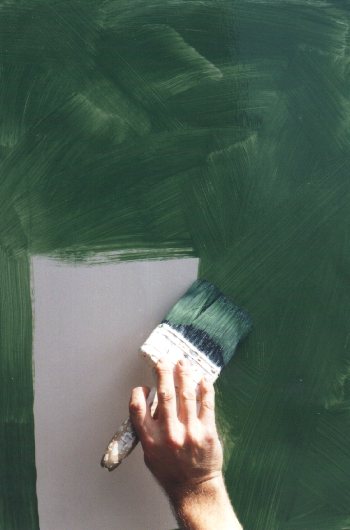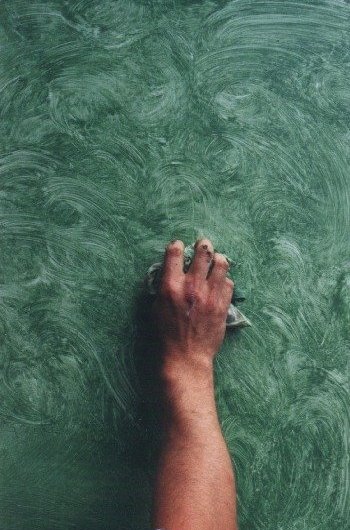- Dust sheets or similar material to protect carpets furniture etc.
- Disposable plastic gloves (optional).
- A bucket or bowl of clean water plus rags for cleaning.
- A tin of paint thinned with transparent glaze according to manufacturers instructions.
- A roller and tray and/or a brush.
- A large flat brush or rag.
Like all paint-effects, clouding can be a little messy, so wear old clothing or overalls.
Also: remove or cover all carpets, furniture and other valuables from the room.
Prepare
the surface that is to be painted, apply at least 2 coats of mid-sheen paint in your chosen
colour
and allow to dry thoroughly.
Water-based paint dries quickly so start on your smallest walls first; your speed will improve with experience.
Have a bucket or bowl of clean water and some rags close at hand for cleaning purposes.
CLOUDING PROCESS.
In this technique the topcoat, or glaze, is patterned by disrupting the evenness of the glaze over the surface to give a cloudy effect.
Where the brush or rag makes contact, the glaze is lifted revealing the base coat.
It is advisable to get someone else to paint the wall with the mixed glaze ahead of you, so that you can concentrate on creating the effect
If you must work alone, paint small sections, 6ft (2 metre) at a time, & stop the clouding process 6 inches (150mm) short of the leading edge.
Apply the mixed glaze evenly with a brush or roller.
Applying gentle pressure; use circular strokes to remove some of the glaze creating an irregular cloudy pattern.
Some people use a semi-circular motion for this effect, switching from one angle to another.
There is no correct method, so try both or create your own.
Everyone's technique is individual, so only one person should create the effect.
Experiment before you try a whole wall, and wipe of what you don't like before the glaze dries.
Occasionally wipe the brush or replace the rag to prevent a build-up of glaze.
Repeat the process over the area to be decorated, lapping-in on wet edges.
Allow the first wall to dry before starting another to prevent spoiling the finished effect.
You may wish to repeat the clouding process with a second colour once the first is dry.
In this instance, it is advisable to switch from using a brush to a rag or vice versa.
Allow the paint to dry before protecting with a coat of clear glaze or varnish (optional).

Apply glaze.

Swirl with a rag.
!!! With oil-based
method, used rags must be laid flat and allowed to dry before discarding to prevent spontanious combustion. !!!
The more contrast between the basecoat and topcoat; the more pronounced the pattern will be.
You should not add white to the basecoat colour to make the topcoat, or vice versa. This gives poor results unless the contrast is strong.
An oil-based basecoat will greatly improve the working time of the glaze. It is advisable to use an oil-based topcoat too in this instance.
A silk or semi-sheen basecoat works best as it provides less suction than a matt finish thereby allowing the brush or rag to glide freely.
Colours should be related in some way, either different tones of the same colour, or similar tones of related colours.
![]()
![]()